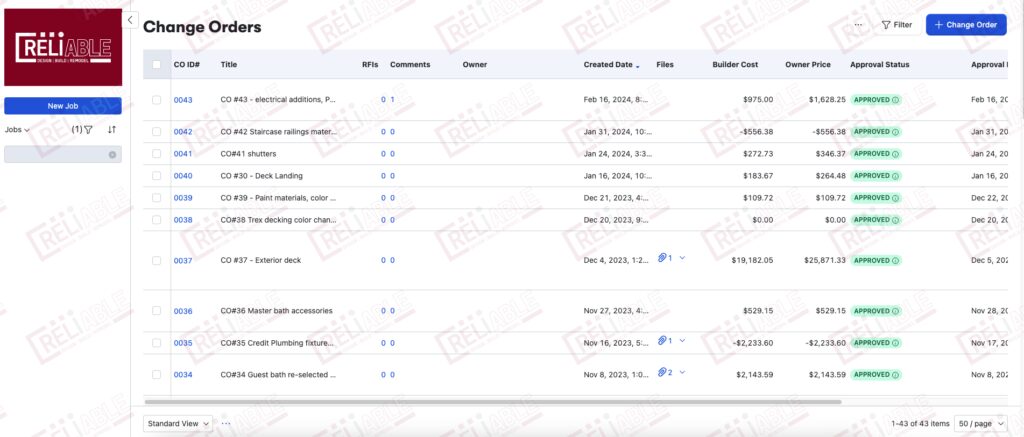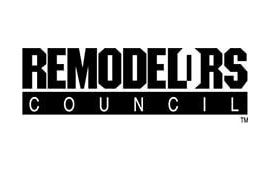
As part of our introductory course for all of our new clients, we’ve created this small blog post that answers one of the most commonly asked questions we receive during a project: “What is a Change Order?”
What is a Change Order?
A change order is a management document that logs changes to a remodeling project’s scope of work. Change orders are massively important not just to the remodeling industry, but to the construction industry as a whole, and they see use in a wide variety of other fields as well, under the same, or different, name.
Simply put, a change order is a list of all the things in a remodeling projects that were changed from the initial scope of work; this can include things added to the project or taken away from the project, the dollar value relating to that, and the timeframe for completion.
A change order is simply a way to modify remodeling contracts in a readable way that can reflect a change in the price and/or completion date of the project. It works as a change management document that addresses any change in the project scope, detailing what needs to happen, how much it’ll cost and when it can be expected to reach completion.
Because the original scope of work and change orders are technically legally binding contracts, change orders aren’t enforced until both the general contractor and the homeowner mutually agree that the project should move forward.

When Should I Use a Change Order?
Change orders aren’t something you specifically “request” per se, what happens is that when you need something different for the project, you bring it up to the contractor. You can write down exactly what changes you’re wanting and provide that to the contractor to make it easier, but even a telephone call will suffice.
The contractor is the one who needs to put your words into remodeling terms; Reliable uses the Buildertrend project management software to keep track of everything in our projects, including change orders!
What Should Be In a Change Order?
Change orders can look very different from one another, depending on how specific that change is. But here is what typically is found in an average change order:
- A new version of the contract that includes how items in the change order affect cost and scheduling.
- The contractor’s name, the homeowner’s name, and identifying numbers unique to the contract and the change order.
- A description of the items in the change order.
- A description of the original scope of work. (For comparison)
- A detailed cost analysis.
- A date for when the change order will be accepted.
Here’s a small list of why you would consider making changes to your project:
- If new risks are presented: Maybe the contractor cannot demolish a wall because of an electrical or plumbing issue that could damage the house.
- Timing problems: As we all know living in Alabama can result in some pretty inconsistent weather, but also sometimes unforeseen problems can happen that affect the timeframe of the project.
- Budgetary reasons: Maybe the project was far more, or less, expensive than the initial scope predicted. This can force homeowners to either expand or shrink the project.
- If materials don’t arrive: If resources don’t arrive on schedule, it can jeopardize the entire project if not quickly accounted for.
Types of Change Orders
There are two types of change orders: Additive and deductive change orders.

Additive
An additive change order is something that adds to the original scope of work, which typically precipitates, but is not always commensurate to, an increase to the budget and schedule of the project. This could be anything from repairing a damaged roof, buying new quartz countertops, or adding a brand new deck on the second floor of the home!
Deductive
A deductive change order is anything that subtracts from the original scope of work, which usually means that there needs to be an overall decrease to the budget of the project. The timeframe being affected does not always need to be shortened however. This can happen for instance when a contractor discovers water damage that is currently damaging the house while working on something completely unrelated, or if the homeowner has simply had second thoughts about buying a more expensive material!

Change orders are a critical part of the change control process. They’re also often part of a process that begins with a request for information (RFI), which is a document that responds to any questions that may arise throughout the execution of a construction project. It’s used to clarify something or ask for additional information. This can often lead to a change in the contract, which then triggers the change order form.
Reliable Design-Build-Remodel is a full service general construction firm and remodeling contractor operating in the Birmingham metro and Jefferson and Shelby County areas and surrounding communities, including Birmingham, Helena, Chelsea, Mountain Brook, Hoover, Homewood, Montevallo, Alabaster, Vestavia Hills, and Pelham, with over 30 years of servicing our valued clients. Offering full service suite of general remodeling, design and build services. Our specialties include bathroom remodeling, kitchen remodeling, exterior renovations, interior renovations, painting, and more!
Visit us at reliablerem.com, and like and follow us on Facebook and Instagram!















